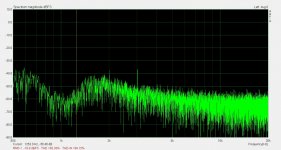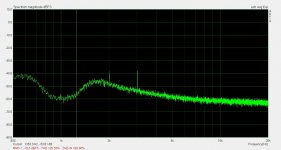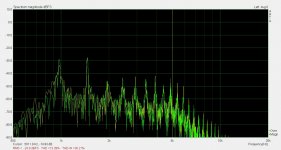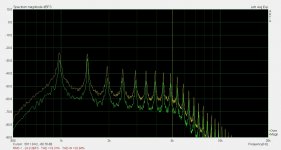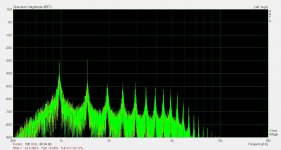Here is the ULD4 and Victors 1 KHz compared. Victors is better BUT the ULD4 comes ready to use.
These are scaled correctly. First is ULD4 , second is Victor's. Also shows how clean things are with battery power. I just wish 9V batteries were not so expensive, especially when I forget to turn it off.
I scored 5 12V gel cells from work. Retired from an alarm system.
Got any friends in the security business?
I have an early 1KHz from Victor to compare to another generator:
One thing you need to watch out for is excessive smoothing by averaging can reduce the true harmonic peak as well as noise.... esp when signal to noise is poor.....near the noise floor... need to be careful not to average too much.
0 is = -100dB re 1volt. In the first photo, Victors is in cyan color.... higher noise level but no harmonics showing and yellow is the other gen... lower noise but -135dB-ish harmonics.
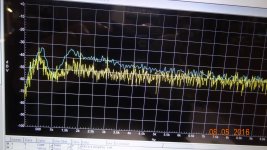
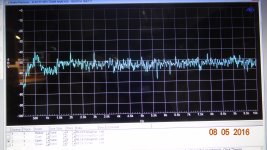
The averaged/smoothed looses about 5-6dB of harmonic amplitude. -135 above vs -140dB below picture.
[The photographs are via ShibaSoku 725D monitor output into an Audio Precision 2722 doing the FFT.]
THx-RNMarsh
One thing you need to watch out for is excessive smoothing by averaging can reduce the true harmonic peak as well as noise.... esp when signal to noise is poor.....near the noise floor... need to be careful not to average too much.
0 is = -100dB re 1volt. In the first photo, Victors is in cyan color.... higher noise level but no harmonics showing and yellow is the other gen... lower noise but -135dB-ish harmonics.


The averaged/smoothed looses about 5-6dB of harmonic amplitude. -135 above vs -140dB below picture.
[The photographs are via ShibaSoku 725D monitor output into an Audio Precision 2722 doing the FFT.]
THx-RNMarsh
Last edited:
Why wouldn't you average and take long samples when measuring near the noise floor? Or did you mean something different?
I don't lose any harmonic level using a little or a lot of averaging.
An average harmonic level is just that an average. The noise compresses to an average as well but the level doesn't change. The amount of data in FFT does change the apperant noise level.
Maybe this is something going on with the 2700.
An average harmonic level is just that an average. The noise compresses to an average as well but the level doesn't change. The amount of data in FFT does change the apperant noise level.
Maybe this is something going on with the 2700.
I tried a peak hold function in Praxis and the harmonics did not change (and they should not if they are real). The noise gets taller.
Here are some screen shots of Victor's oscillator.
The first is with no averaging.
The second is with exponential averaging.
With out averaging I see the harmonic levels bouncing up and down as much a 6dB. WITH that it's impossible to determine what the level is. So averaging must be used. All of our measurements off the meter or FFT are average harmonic levels.
The first is with no averaging.
The second is with exponential averaging.
With out averaging I see the harmonic levels bouncing up and down as much a 6dB. WITH that it's impossible to determine what the level is. So averaging must be used. All of our measurements off the meter or FFT are average harmonic levels.
Attachments
Last edited:
I tried a peak hold function in Praxis and the harmonics did not change (and they should not if they are real). The noise gets taller.
How can a peak hold function tell you if the harmonic level are changing? It just hold the peak.
"Peak" level same level as averaged level on harmonics. Noise levels higher.
I don't see fluctuations on the harmonics any more than the fundamental. I'm sampling at 192KHz and using 262144 points with magnitude averaging. How are you set?
I don't see fluctuations on the harmonics any more than the fundamental. I'm sampling at 192KHz and using 262144 points with magnitude averaging. How are you set?
You won't see it with a wide data set. The update rate is to slow and your averaging a large data set.
Se it to 8192 with no averaging and greater resolution bandwidth 44.1ksps.
Se it to 8192 with no averaging and greater resolution bandwidth 44.1ksps.
This is an overlay with a large data set. No averaging.
131072
Not much change here at all.
My point is if the harmonic level changes with long averaging it because the average really has changed.
It's not a measurement error. Averaging will not do this.
131072
Not much change here at all.
My point is if the harmonic level changes with long averaging it because the average really has changed.
It's not a measurement error. Averaging will not do this.
Attachments
Last edited:
I know my description is confusiong. What I want to do is scale the output of the 725 to match the input. If the 725 is boosting the input by 70 dB I want to scale the display so the indicated levels are scaled correctly and a -130 dB harmonic is displayed at -130 dB.
I'll try your method and see if I can make it work. Essentially enter 1V and set the cal to .1 mV. In Praxis there is a simple offset field independent of calibration.
I sometimes insert a pot or even a ten-turns pots at the input of the sound card to adjust the 0 dB level within a precision of 0.1 dB in the window of ARTA or similar programs.
The averaging with the AP seems to be more arithmatic/analog than FFT.
BTW -- The 725D and the AP2722 agree on individual harmonic levels within 0.5dB of each other down to -140.
Here is the same monitor output with same generators but with QA400 doing the FFT. The QA400 can do well with this limited dynamic range of the monitor output. But it indicates about 3dB lower for 2H than the other two. I can live with that. [no it isnt in the calibration]
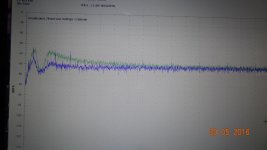
Green is Victor's generator.
THx-RNMarsh
BTW -- The 725D and the AP2722 agree on individual harmonic levels within 0.5dB of each other down to -140.
Here is the same monitor output with same generators but with QA400 doing the FFT. The QA400 can do well with this limited dynamic range of the monitor output. But it indicates about 3dB lower for 2H than the other two. I can live with that. [no it isnt in the calibration]

Green is Victor's generator.
THx-RNMarsh
Last edited:
Richard:
You need to get some way (Wifi, powerline??) to connect your machines to the network. The pictures would be much nicer. I use UltraVNC for remote access and the snipping tool to make PNG's of what I'm sharing. Its really the easiest.
You need to get some way (Wifi, powerline??) to connect your machines to the network. The pictures would be much nicer. I use UltraVNC for remote access and the snipping tool to make PNG's of what I'm sharing. Its really the easiest.
I am not sure where the string of harmonics from the ULD4 are from. Something is odd. I'll be reshooting them when I can get in front of the stuff with fresh batteries for victors oscillator etc.
Richard:
You need to get some way (Wifi, powerline??) to connect your machines to the network. The pictures would be much nicer. I use UltraVNC for remote access and the snipping tool to make PNG's of what I'm sharing. Its really the easiest.
Not really hard to see......
All you need to do is move your cursor to the picture and click on it. That will blow it up to full screen size.
-RM
Last edited:
The averaging with the AP seems to be more arithmatic/analog than FFT.
BTW -- The 725D and the AP2722 agree on individual harmonic levels within 0.5dB of each other down to -140.
Here is the same monitor output with same generators but with QA400 doing the FFT. The QA400 can do well with this limited dynamic range of the monitor output. But it indicates about 3dB lower for 2H than the other two. I can live with that. [no it isnt in the calibration]
View attachment 547918
Green is Victor's generator.
THx-RNMarsh
I don't dispute the accuracy either the 725 or the 2700.
Some time the overlay are displaced to make it easier to see them. ATRA for example will do both an exact overlay or difference between them in which the overlay are displaced.
I showed that there is no difference with or with out averaging. Nothing wrong with the math in ARTA. If your getting different harmonic levels with and with out averaging then something else is going on that perhaps your not aware of.
The average of constant is the constant. (2+2+2+2) / 4 = 2.
I'll repeat what you did with the QA.
Some time the overlay are displaced to make it easier to see them. ATRA for example will do both an exact overlay or difference between them in which the overlay are displaced.
I showed that there is no difference with or with out averaging. Nothing wrong with the math in ARTA. If your getting different harmonic levels with and with out averaging then something else is going on that perhaps your not aware of.
The average of constant is the constant. (2+2+2+2) / 4 = 2.
I'll repeat what you did with the QA.
I was not talking about ARTA (which i didnt use) nor QA. I was talking about the averaging method used by AP made it less accurate when close to noise floor, as shown.
The AP is also Much harder to use and setup and gathering the data than QA for this purpose. But the AP is more accurate (no surprise), if careful.
I did not see any harmonics from Victor's with AP or QA400 doing the FFT except that it is noisier than the AG16B. Now that I can better see what I am doing, I'll retune the AG16B for lower distortion (if possible).
THx-RNMarsh
Last edited:
- Home
- Design & Build
- Equipment & Tools
- Low-distortion Audio-range Oscillator
